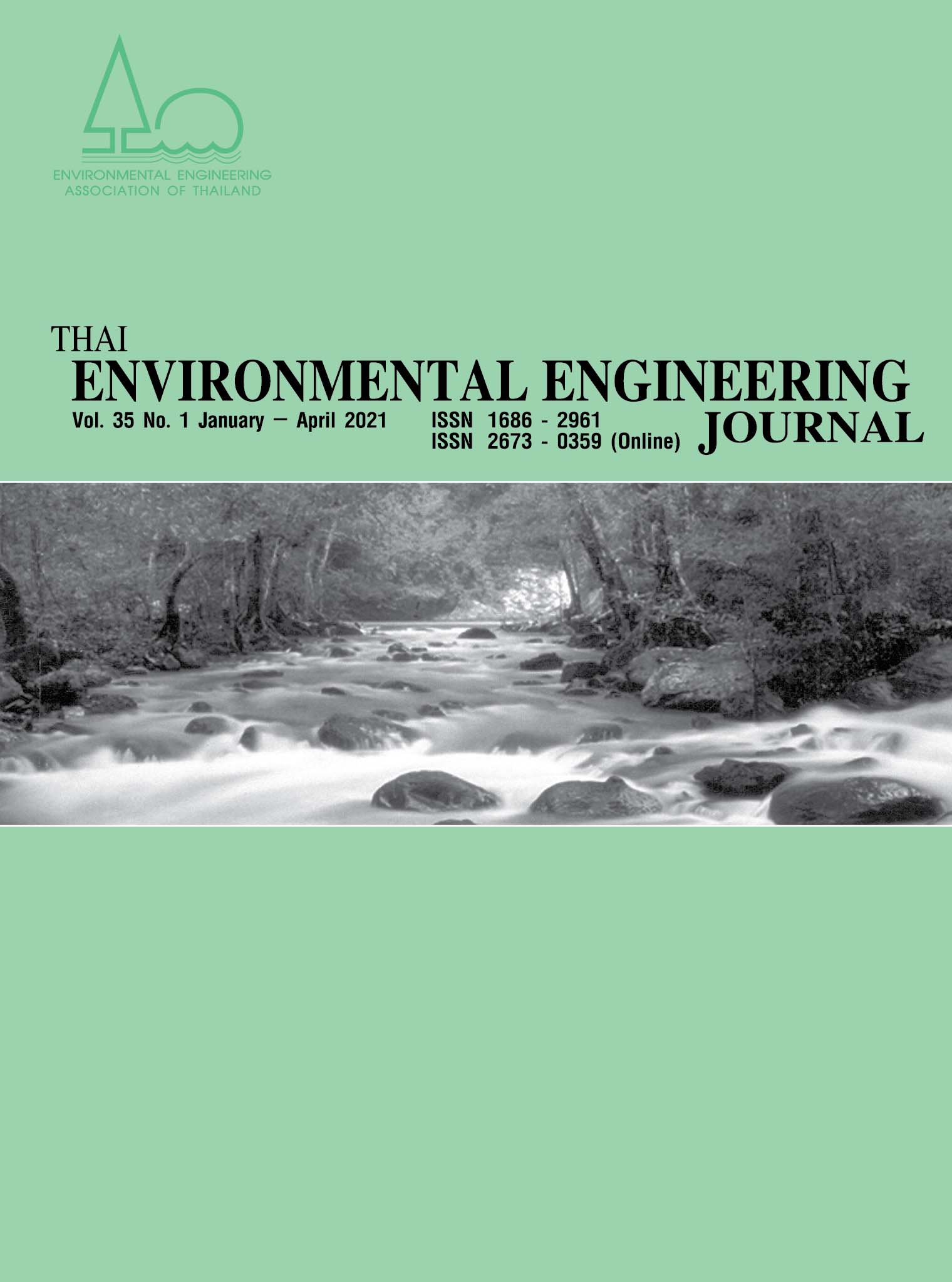Performance of Dairy Wastewater Intrinsic Bacteria in Microbial Fuel Cell
Main Article Content
Abstract
The use of wastewater in microbial fuel cell (MFC) simultaneously clean up the waste and generate electricity. While organic matters in wastewater serve well as electron donor, electrode-reducing bacteria are responsible for transferring electron to anode. This study investigated the performance of intrinsic bacteria in dairy wastewater in oxidizing organic content and generating electric current. The experiment was conducted in a dual chamber MFC with graphite electrodes. The variables were electrode surface area and wastewater concentration. An increase in bacterial population, a decrease in organic content (COD) and electric current obtained over the test period confirmed bacterial activity. Electric current generation was found to increase with electrode surface area. In the 1.7 L chamber with initial COD of 2500 mg/L, the maximum current of 307.6 µA and 635.12 µA 307 across a standard 1k ohm were obtained from the 78 and 150 cm2 electrodes, respectively. Current generation was found to vary with organic concentrations. In the 1 L chamber using 78 cm2 electrodes with initial COD of 1000 and 400 mg/L, the maximum current were lower, at 42.57 µA and 4.99 µA, respectively. Coulombic efficiency obtained from this study was in the range of 0.13-2.64%. Bacterial identification by PCR-DGGE and DNA sequencing showed that Acidobacterium sp. and Azovibrio restrictus were the predominant species on the anode with 8 anaerobic species predominated in suspension.
Article Details
References
Du, Z., Li, H., Gu, T.A. 2007. A state of the art review on microbial fuel cells: A promising technology for wastewater treatment and bioenergy. Biotechnology Advances. 25(5): 464-482.
Logan, B.E., Hamelers, B., Rozendal, S., Schröder, U., Keller, J., Freguia, S., Aelterman, P., Verstraete, W., Rabaey, K. 2006. Microbial fuel cells: methodology and technology. Environmental Science & Technology. 40: 5181-5192.
Berchmans, S. Microbial Fuel Cell as alternate power tool : potential and challenges. In: Das, D. Microbial Fuel Cell, Springer Cham, 2018: 403-419.
Pandi, S., Kuppam, C., Kakarla, R., Kadier, A., Jeevitha, V. Basic Principles of Microbial Fuel Cell: Technical Challenges and Economic Feasibility. In: Kalia, V.C., Kumar, P. Microbial Application, Springer, 2017: 165-188.
Bretschger, O., Gorby, Y.A., Nealson, K.H. A survey of direct electron transfer from microbes to electronically active surfaces. In: Rabaey K. Bioelectrochemical Systems: from extracellular electron transfer to biotechnological application, IWA publishing; 2010.
Shi, L., Dong, H., Reguera, G. 2016. Extracellular electron transfer mechanisms between microorganisms and minerals. Nature. Review Microbiology. 14: 651-662.
Logan, B.E., Rabaey, K. 2012. Conversion of wastes into bioelectricity and chemicals by using microbial electrochemical technologies. Science. 337: 686-690.
Lovley, D. R. 2008. The microbe electric: conversion of organic matter to electricity. Current Opinion in Biotechnology. 19: 564-571.
Kim, B.H., Park, H.S., Kim, H.J. 2004. Enrichment of microbial community generating electricity using a fuel-cell-type electrochemical cell. Applied Microbiology Biotechnology. 63: 672-81.
Kim, H.J., Park, H.S., Hyun, M.S., Chang, I.S., Kim, M., Kim, B.H. 2002. A mediator-less microbial fuel cell using a metal reducing bacterium, Shewanella putrefaciens. Enzyme Microbial Technology. 30: 145-152.
Bond, D.R., Lovley, D.R. 2003. Electricity production by Geobacter sulfurreducens attached to electrodes. Applied and Environmental Microbiology. 69(3): 1548-1555.
Bond, D.R., Lovley, D.R. 2005. Evidence for involvement of an electron shuttle in electricity generation by Geothrix fermentans. Applied Environmental Microbiology. 71: 2186-2189.
Chaudhuri, S.K., Lovley, D.R. 2003. Electricity generation by direct oxidation of glucose in mediatorless microbial fuel cells. Nature Biotechnology. 21: 1229-1232.
Chung, K., Okabe, S. 2009. Characterization of electrochemical activity of a strain ISO2‐3 phylogenetically related to Aeromonas sp. isolated from a glucose‐fed microbial fuel cell. Biotechnology & Bioengineering. 104: 901-910.
Xu, S., Liu, H. 2011. New exoelectrogen Citrobacter sp. SX-1 isolated from a microbial fuel cell. Applied Microbiology. 111(5): 1108-1115.
Watanabe, K. 2008. Recent developments in microbial fuel cell technologies for sustainable bioenergy. Bioscience and Bioengineering. 106(6): 528-536.
Kan, J., Hsu, L., Cheung, A., Pirbazari, M., Nealsin, K. 2011. Current production by bacterial communities in Microbial Fuel Cells enriched from wastewater sludge with different electron donors. Environmental Sciences and Technology. 45(3): 1139-1146.
Juang, D. 2012. Organic removal efficiencies and power production capabilities of Microbial Fuel Cell. Process Biochemistry. 39: 1007-1012.
Norgaard, C.E., Nielsen, U.G., Skou, E.M. 2012. Preparation of Nafion 117™-SnO2 composite membranes using an ion-exchange method. Solid State Ionics. 213: 76-82.
Baird, R.B., Eaton, A.D., Rice, E.W. 2017. Standard Methods for the examination of water and wastewater 23rd ed. American Water Works Association.
Felske, A., Engelen, B., Nubel, U., Backhaus, H. 1996. Direct ribosome isolation from soil to extract bacterial rRNA for community analysis. Applied and Environmental Microbiology. 62(11): 4162-4167.
Capodaglio, A.G., Molognoni, D., Dallago, E., Liberale, A., Cella, R., Longoni, P., Pantaleoni, L. 2013. Microbial Fuel Cells for Direct Electrical Energy Recovery from Urban Wastewaters. The Scientific World Journal [Internet] [cited 2013 Oct 5]. Available from: http://dx.doi.org/10.1155/2013/634738
Zhang, Y., Min, B., Huang, L., Angelidaki, I. 2011. Electricity generation and microbial community response to substrate changes in microbial fuel cell. Bioresource Technology. 102(2): 1166-1173.
Zhang, B., Zhang, J., Liu, Y., et al. 2013. Identification of removal principles and involved bacteria in Microbial Fuel Cells for sulfide removal and electricity generation. International Journal of Hydrogen Energy. 38: 14348-14355.


